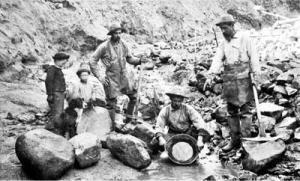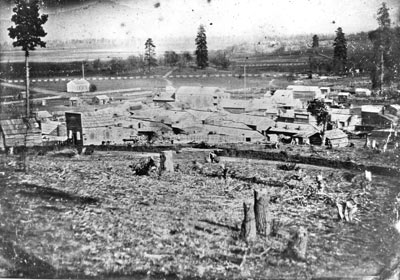Pioneer Profiles – May 2014
In the mid-1800s, the promise of gold and free land lured fortune seekers and settlers to the newly-formed Oregon Territory. They were soon followed by merchants who amassed their own wealth, selling supplies to the miners and farmers. This on-going series shares the stories of these pioneers and their times.
As late as 1851, the Rogue Valley was still very much “the realm of Indians,” writes Stephen Dow Beckham in Requiem for a People: The Rogue Indians and the Frontiersmen. Settlements were “limited to a few hardy outposts.”
Judge L.L.C. Duncan, who established a farm on Bear Creek in the fall of 1851, noted the presence of two Rogue River ferry operators, Perkins and Evans, who were taking advantage of the growing number of mule “packers” hauling freight from points north to the gold fields in California. Asa Skinner, the Indian Agent, had a small log cabin at the base of Lower Table Rock. N.T. Dean had a place at Willow Springs, and there was a settler named Bills, who was later driven off for “consorting with the Indians.” A.G. Walling, in his History of Southern Oregon, reported some 27 residents in the area as of December 1851.
However, when James Clugage publicized the Rich Gulch gold discovery that winter, that number rapidly changed. (See February Jacksonville Review, “The Fathers of Jacksonville.”)
As word of the strike at Rich Gulch spread, “an eruption of miners” flocked to the Rogue Valley from throughout the northwest, searching the streambeds and gulches for gold. According to Walling, by “late February 1852 every foot of the gulch was staked out and claimed and by March the surrounding hills and gulches were, in spite of the evident hostility of the Indians, filled with the rapidly swelling population.” Within a few months, over 3,000 miners were claiming and excavating every creek bed in the region, and the hillsides were dotted with the tents and camps of prospectors seeking gold!
The merchants and purveyors of supplies and services arrived close on their heels. By February of 1852, Appler and Kenney had moved up from Yreka and opened a trading post, the area’s first “house of commerce.” It was by no means a bazaar. Their stock consisted of a few tools, a little “tom iron”—perforated sheet metal used to make rockers and long toms for mining—rough clothing and boots, some “blackstrap” tobacco, and a liberal supply of whiskey, “the solace of the miner in heat and cold, in prosperity or in adversity.”
Other traders followed, bringing supplies of every kind, pitching their tents on any available ground, and finding plenty of customers flush with treasure from their diggings.
W.W. Fowler constructed the community’s first building near the head of Main, the only street in the embryo city. It was a canvas topped log house, probably a store or saloon. Mining camps tended to last only as long as the promise of gold so it’s unlikely Fowler would have invested that kind of money in a place to live.
By March, other principal places of business were “the round tent of Miller & Wills” opposite Fowler’s log building, and “one large square blue tent east of V. Schutz brewery.”
 Kinney and Appler had apparently built “a clapboard house on northeast corner of Oregon and California streets” which Henry Kippel (see March Jacksonville Review, “Pioneer, Soldier, Citizen”) called “the most pretentious house in town.”
Kinney and Appler had apparently built “a clapboard house on northeast corner of Oregon and California streets” which Henry Kippel (see March Jacksonville Review, “Pioneer, Soldier, Citizen”) called “the most pretentious house in town.”
Per his description, “It was built of shakes; the studding, plates and rafters were improvised out of fir poles; there were no sills to the house; the posts or studding were stuck in the ground; window openings were covered with canvas; and doors were made out of fir poles covered with shakes.” Klippel could safely say that “not a sawed stick of timber of any description was used in the building.”
However, timber was abundant, so lumber was soon “whipsawed” in the gulches at the rate of $250 per thousand board feet, or purchased in small quantities from an enterprising settler who brought a small sawmill in the valley. Clapboard houses, with real sawed doors and window frames, began to rise among the tents. By the end of summer, the town had assumed an air of solidity.
A marked change also took place in the social structure. Gamblers, courtesans, and con men of every kind flocked to the new El Dorado. Saloons multiplied—36 at one count.
Klippel again describes the scene. “Sunday, as now, was considered a day of rest! Miners would as a rule go to town and have a good time, see the sights, and “buck the tiger*.” The chief place of amusement was Wills & Miller’s round tent; here gambling was wide open and in full sway, monte being the principal game dealt. It was easily understood and patronized by seventy-five percent of the population; I presume, on the supposed theory, that to ‘bust’ the game would keep down its evil influences.
“The Indians were frequent visitors to the town and they were fond of taking the chances. On one occasion war chief Sam was a looker-on at the round tent, and after intently watching the game for a time put down a half dollar on the layout and lost it. Not in the least dismayed at the result, he continued betting until he lost all of his money; by this time the other
“Sam took off his coat, vest and pants, bet them in the order named at an agreed price with the dealer and lost them all. He wore a plug hat; he took it off, looked at it, put it back on his head again and turned to leave the tent, whereupon the dealer called to him and gave him back his clothes.”
Klippel describes Chief Sam as “a very large man, well proportioned, and whilst standing there in that crowded tent, minus clothes, excepting that plug hat, looked a veritable giant. Indifferent to his surroundings, he evinced no chagrin at the result; on the contrary, nature’s garb seemed to make him more dignified. I have often thought since, what a rare model he would have made for an artist, and what a grand picture he would have afforded the average Kodak fiend.”
A Kodak moment indeed!
*Editor’s Note: Faro, a favored card game during the Gold Rush, was sometimes referred to as “Bucking the Tiger.” This is thought to have come from early card backs that featured a drawing of a Bengal Tiger.
